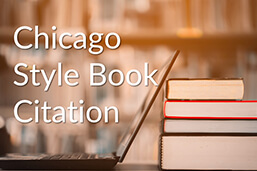
The Chicago style guide is used widely alongside MLA and APA style in various disciplines. In academic writing, the Chicago style book citation is one of the most preferred formatting styles for citing book sources. It includes two systems: notes and bibliography, and author-date. Depending on which system is used, the in-text citations and reference entries are presented differently. Implementing the style correctly is vital in order to give the original authors proper credit to avoid plagiarism.
Definition: Chicago style book citation
The Chicago style book citation refers to the method of citing literary sources in Chicago style paper.
Although it is used more for published works than class papers, it is a crucial writing format necessary to ensure research papers cite sources correctly. This prevents plagiarism and ensures uniformity of research papers across the
scientific community.
In Chicago style book citation, we include the bibliography and full and short notes.
- Full notes are included to show more information about the book, for instance, the edition or volume, editor, and notable translators.
- Short notes in Chicago style book citations are structured in the same format throughout the text.
Chicago style book citation format:
| Full note: | First name and last name of the author. Title of book: Subtitle. (Publication place: Name of Publisher, Year). Page range. |
| Short note: | Author's last name, Title of Book (Shortened), Page range. |
| Bibliography: | Last name of the author, first name. Title of Book: Subtitle. Publication Place: Publisher name, Year. |
in Your Thesis
Chicago style book citation: Chapters
Chicago style book citation dictates that you should mention the chapter instead of the whole anthology or collection. Use the author-title format to refer to the chapter and provide additional book details. In a note, the editor is introduced by the prefix “ed” while “edited by” is used in a bibliography.
Citing chapters in Chicago style book citation:
| Full note: | First name and last name of author. "Title of chapter." In Title of Book: Subtitle, ed. First name and last name of the editor (Publication place: Name of Publisher, Year), Page range. |
| Short note: | Last name of author, "Chapter title (shortened)," Page range. |
| Bibliography: | Last name, first name. "Title of Chapter." In Title of Book: Subtitle, edited by First name last name of the editor, Page numbers. Place of publication: Name of Publisher, Year. |
Chicago style book citation: Citing editions
Each edition is usually labeled according to the order of release, such as “Third edition” or labeled as “Revised Edition” or “New Edition” and should be mentioned in Chicago style book citation. Use abbreviations to indicate the edition in your citation, for instance, “3rd ed.” or “rev. ed.”.
Citing editions in Chicago style book citation:
| Full note: | First name and last name of author, Title of Book: Subtitle, edition. (Publication place: Publisher, Year), Page range. |
| Short note: | Last name of author. Title of Book (Shortened), Page number. |
| Bibliography: | Last name of author, first name. Title of Book: Subtitle. Edition, Place of publication: Name of Publisher, Year. |
Chicago style book citation: Translations
Translated versions can be used in Chicago style book citations, as long as the translator and the author are mentioned. We use the abbreviation “trans.” to stand for “Translated by” in the citation; however, the complete phrase should be used in the bibliography.
Citing translated books in Chicago style book citation:
| Full note: | First and last name of the author, Title of Book: Subtitle, trans. First and last name of the translator (Publication place: Name of Publisher, Year), Page number. |
| Short note: | Last name of author, Shortened Title of Book, Page range. |
| Bibliography: | Last name of the author, first name. Title of Book: Subtitle. Translated by first and last name of the translator. Place of Publication: Name of Publisher, Year. |
Chicago style book citation: Online and e-books
Digital format books or e-books are also used in Chicago style book citations as primary and secondary sources of information. When citing e-books, mention the location and specific format in the citation. Mention the DOI or URL at the end of the citation if there are no specified page numbers.
Citing online books in Chicago style book citation:
| Full note: | First and last name of the author, Title of Book: Subtitle, (Place of Publication: Name of Publisher, Year), Page range or Another locator, URL or DOI. |
| Short note: | Last name of author, Shortened Title of Book, Page number or Another locator. |
| Bibliography: | Last name of the author, first name. Title of Book: Subtitle. Place of Publication: Name of Publisher, Year, DOI, or URL. |
Citing e-books in Chicago style book citation:
When citing an e-book in Chicago style book citation, indicate the device type or the format.
| Full note: | First and last name of the author, Title of Book: Subtitle, (Place of publication: Name of Publisher, Year), Page range or Another locator, Format. |
| Short note: | Last name of the author, Shortened title, Page number or Another locator. |
| Bibliography: | Last name of the author, first name. Title of Book: Subtitle, Place of Publication: Name of Publisher, Year. Format. |
FAQs
There are different formats for citing short notes, bibliographies, and full notes. However, they always include:
- Author’s name
- Publisher
- Book title
An online book is located and viewed within its hosting platform, while an e-book is a downloadable digital book available in different formats.
Both are used in Chicago style book citations.
Highlight the specific chapter and the author first. Include the details of the whole book in the bibliography.
Some books, such as online books, may not have defined page numbers. You can use an alternative identifier, such as the chapter number or URL.
